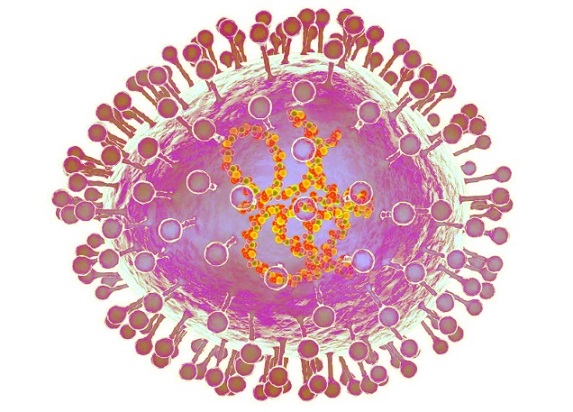Nikhil Prasad Fact checked by:Thailand Medical News Team Jan 04, 2025 3 months, 1 week, 2 days, 1 hour, 9 minutes ago
Medical News: Human metapneumovirus (HMPV) is a relatively recent discovery in the realm of virology, first identified in 2001. Despite being a newcomer to scientific understanding, HMPV has proven itself as a significant cause of respiratory tract infections globally. According to researchers from the Department of Molecular and Cellular Biochemistry at the University of Kentucky and the School of Medicine at the University of Pittsburgh-USA, nearly everyone contracts HMPV by the age of five, with reinfections occurring throughout life.
 Understanding Human Metapneumovirus Fusion Mechanism
Understanding Human Metapneumovirus Fusion Mechanism
The virus can cause symptoms ranging from mild coughing to severe pneumonia, particularly affecting infants, the elderly, and immunocompromised individuals.
Given its ubiquity and potential for severe outcomes, scientists have been striving to unravel the intricacies of HMPV’s infection mechanism. Despite its global prevalence, no FDA-approved treatments or vaccines are available. This
Medical News delves into a groundbreaking study analyzing the HMPV fusion protein (F), a crucial element in the virus’s ability to infect human cells. The study highlights findings that could pave the way for novel therapeutic interventions.
The Role of the Fusion Protein
HMPV, like many enveloped viruses, relies on a fusion protein to invade host cells. The protein facilitates the merging of the viral membrane with the host cell membrane, a process essential for initiating infection. The fusion protein, or F, undergoes activation through proteolytic cleavage, transitioning from a precursor form to a highly reactive state capable of driving membrane fusion.
The complexity of this protein’s activation has been a focal point for scientists. Previous research indicated that specific residues, such as histidine at position 435 (H435), play a role in the protein’s ability to respond to low pH environments. This sensitivity to pH is a key aspect of the virus’s fusion mechanism, particularly for strains classified within clade A of HMPV. However, not all strains exhibit the same behavior, prompting further investigation.
The New Study
Researchers examined three distinct HMPV strains: TN94-49, TN96-12, and TN83-1211. These strains provided a unique opportunity to explore variations in fusion activity, protein expression, and activation mechanisms. The study revealed striking differences between the strains:
-TN94-49: This strain demonstrated fusion activity in low pH conditions despite lacking a glycine residue (G294) previously thought to be critical for this process.
-TN96-12: Unlike the other strains, TN96-12 failed to mediate cell-to-cell fusion in both neutral and low pH environments, indicating the presence of additional, yet unidentified, requirements for F protein activation.
-TN83-1211: This strain exhibited a hyperactive fusion phenotype, driven by a unique histidine r
esidue at position 434 (H434), adjacent to the critical H435.
These findings underscore the diverse and intricate nature of HMPV’s fusion mechanisms, revealing that minor genetic differences can have profound effects on the virus’s infectivity.
Key Findings of the Research
One of the most significant discoveries involved the TN83-1211 strain. Researchers found that the presence of H434 enhanced the protein’s response to low pH, resulting in increased membrane fusion activity. By introducing a similar mutation (Q434H) into another strain, they confirmed that this single amino acid change was sufficient to replicate the hyperactive behavior observed in TN83-1211.
Another notable observation was the role of protein expression levels. The hyperactive strains displayed higher levels of both total and surface-expressed fusion proteins. These elevated levels likely contribute to their increased fusion activity. However, the case of TN96-12, which showed high protein expression but no fusion activity, suggests that surface expression alone is not enough. This finding highlights the potential involvement of other cellular factors or conditions required for activation.
The study also examined the cleavage efficiency of the fusion protein by trypsin, a step critical for its activation. The hyperactive strains showed significantly higher cleavage levels compared to less active strains, reinforcing the importance of this process in determining fusion capability.
Implications for Antiviral Development
Understanding the nuances of HMPV’s fusion mechanisms could have far-reaching implications. By identifying the specific residues and conditions necessary for activation, researchers can target these features to develop antiviral drugs. For example, inhibitors designed to block the activation or function of the fusion protein could effectively prevent the virus from infecting host cells.
Moreover, the study highlights the potential for vaccine development. By manipulating the fusion protein to reduce its activity or stability, scientists could create attenuated viruses suitable for vaccine use. Such strategies could protect vulnerable populations, including infants and the elderly, from severe respiratory illnesses caused by HMPV.
Conclusions
The findings of this study offer a deeper understanding of the human metapneumovirus and its mechanisms for infecting human cells. The discovery of the critical role played by specific residues, such as H434 and H435, opens new avenues for research and therapeutic intervention. Additionally, the identification of diverse behaviors among different HMPV strains underscores the need for tailored approaches to combat this virus effectively.
Future research should focus on exploring the unidentified factors influencing the activation of strains like TN96-12. A comprehensive understanding of these mechanisms could unlock new strategies for preventing and treating HMPV infections, benefiting millions of people worldwide.
The study findings were published in the peer-reviewed journal: Virology.
https://www.sciencedirect.com/science/article/pii/S0042682219300686
For the latest HMPV News, keep on logging to Thailand
Medical News.
Read Also:
https://www.thailandmedical.news/news/phytochemicals-from-marine-algae-offer-hope-in-combating-hmpv-infections
https://www.thailandmedical.news/news/the-phytochemical-gamma-fagarine-from-the-root-of-zanthoxylum-bungeanum-is-an-effective-antiviral-against-hmpv
https://www.thailandmedical.news/news/columbia-university-study-finds-that-the-phytochemical-ginkgolic-acid-can-inhibit-human-metapneumovirus-infectivity
https://www.thailandmedical.news/news/probenecid-shows-promise-against-respiratory-virus-human-metapneumovirus-hmpv
https://www.thailandmedical.news/news/californian-study-confirms-hpmv-is-neurotropic-and-causes-cns-issues-like-febrile-seizures-and-fatal-encephalitis-in-children
https://www.thailandmedical.news/articles/hmpv-human-metapneumovirus
